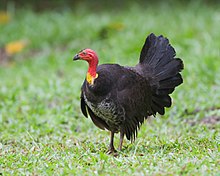Loading AI tools
Superorder of birds From Wikipedia, the free encyclopedia
Fowl are birds belonging to one of two biological orders, namely the gamefowl or landfowl (Galliformes) and the waterfowl (Anseriformes). Anatomical and molecular similarities suggest these two groups are close evolutionary relatives; together, they form the fowl clade which is scientifically known as Galloanserae or Galloanseres (initially termed Galloanseri) (Latin gallus ("rooster") + ānser ("goose")).[3] This clade is also supported by morphological and DNA sequence data[4] as well as retrotransposon presence/absence data.[5]
| Fowl Temporal range:
Possibly an earlier origin based on molecular clock[2] | |
|---|---|
 | |
| Australian brushturkey (Alectura lathami) | |
| Scientific classification | |
| Domain: | Eukaryota |
| Kingdom: | Animalia |
| Phylum: | Chordata |
| Class: | Aves |
| Infraclass: | Neognathae |
| Clade: | Pangalloanserae |
| Superorder: | Galloanserae Sclater, 1880 |
| Subgroups | |
| Synonyms | |
|
Anatophasianae | |
As opposed to "fowl", "poultry" is a term for any kind of domesticated bird or bird captive-raised for meat, eggs, or feathers; ostriches, for example, are sometimes kept as poultry, but are neither gamefowl nor waterfowl. In colloquial speech, however, the term "fowl" is often used near-synonymously with "poultry", and many languages do not distinguish between "poultry" and "fowl". Nonetheless, the fact that the Galliformes and Anseriformes most likely form a monophyletic group makes a distinction between "fowl" and "poultry" warranted.
The historic difference in English is due to the Germanic/Latin split word pairs characteristic of Middle English; the word 'fowl' is of Germanic origin (cf. Old English "fugol", West Frisian fûgel, Dutch vogel, German Vogel, Swedish fågel, Danish/Norwegian fugl), whilst 'poultry' is of Latin via Norman French origin;[6][7] the presence of an initial /p/ in poultry and an initial /f/ in fowl is due to Grimm's Law.
Many birds that are eaten by humans are fowl, including poultry such as chickens or turkeys, game birds such as pheasants or partridges, other wildfowl like guineafowl or peafowl, and waterfowl such as ducks or geese.
While they are quite diverse ecologically and consequently, in an adaptation to their different lifestyles, also morphologically and ethologically, some features still unite water- and landfowl. Many of these, however, are plesiomorphic for Neornithes as a whole, and are also shared with paleognaths.[citation needed]
From the fossils that have to date been recovered, the conclusion that the Galloanserae were already widespread by the end of the Cretaceous is generally accepted nowadays. A combination of fossils and molecular clocks estimated the origin of Galloanserae at 85 million of years ago.[9] Fossils such as Vegavis indicate that essentially modern waterfowl, albeit belonging to a now-extinct lineage, were contemporaries of the non-avian dinosaurs. While the dominant avialans of the Mesozoic Era, the Enantiornithes, died out with all other non-avian dinosaurs, the Galloanserae (fowl) survived to become the first successful group of modern birds after the other dinosaurs died out.
As opposed to the morphologically fairly conservative Galliformes, the Anseriformes have adapted to filter-feeding and are characterized by many autapomorphies related to this lifestyle. The extremely advanced feeding systems of the Anseriformes, together with similarities of the early anseriform Presbyornis to shorebirds, had formerly prompted some scientists to ally Anseriformes with Charadriiformes, instead.[10][11] However, as strong support for the Galloanserae has emerged in subsequent studies, the fowl clade continues to be accepted as a genuine evolutionary lineage by the vast majority of scientists.
Fowl have deep spiritual meanings and roots in ancient cultures, such as Hinduism in India and in many Pagan cultures throughout the world. The peacock, for example, represents truth, beauty, honor, and strength and dreams of peacocks are referred to as good omens.[12]
Fowl are frequently kept for both meat and eggs. Chickens, by far, are the most heavily consumed and farmed out of all of them. Other fowl commonly used in cooking include ducks, geese, turkeys and quail.
Various species of fowl are hunted for both sport and food. Pheasants have been widely introduced and naturalized outside of their native range in Asia to Europe and North America for use as food and sport.[13]
Seamless Wikipedia browsing. On steroids.
Every time you click a link to Wikipedia, Wiktionary or Wikiquote in your browser's search results, it will show the modern Wikiwand interface.
Wikiwand extension is a five stars, simple, with minimum permission required to keep your browsing private, safe and transparent.